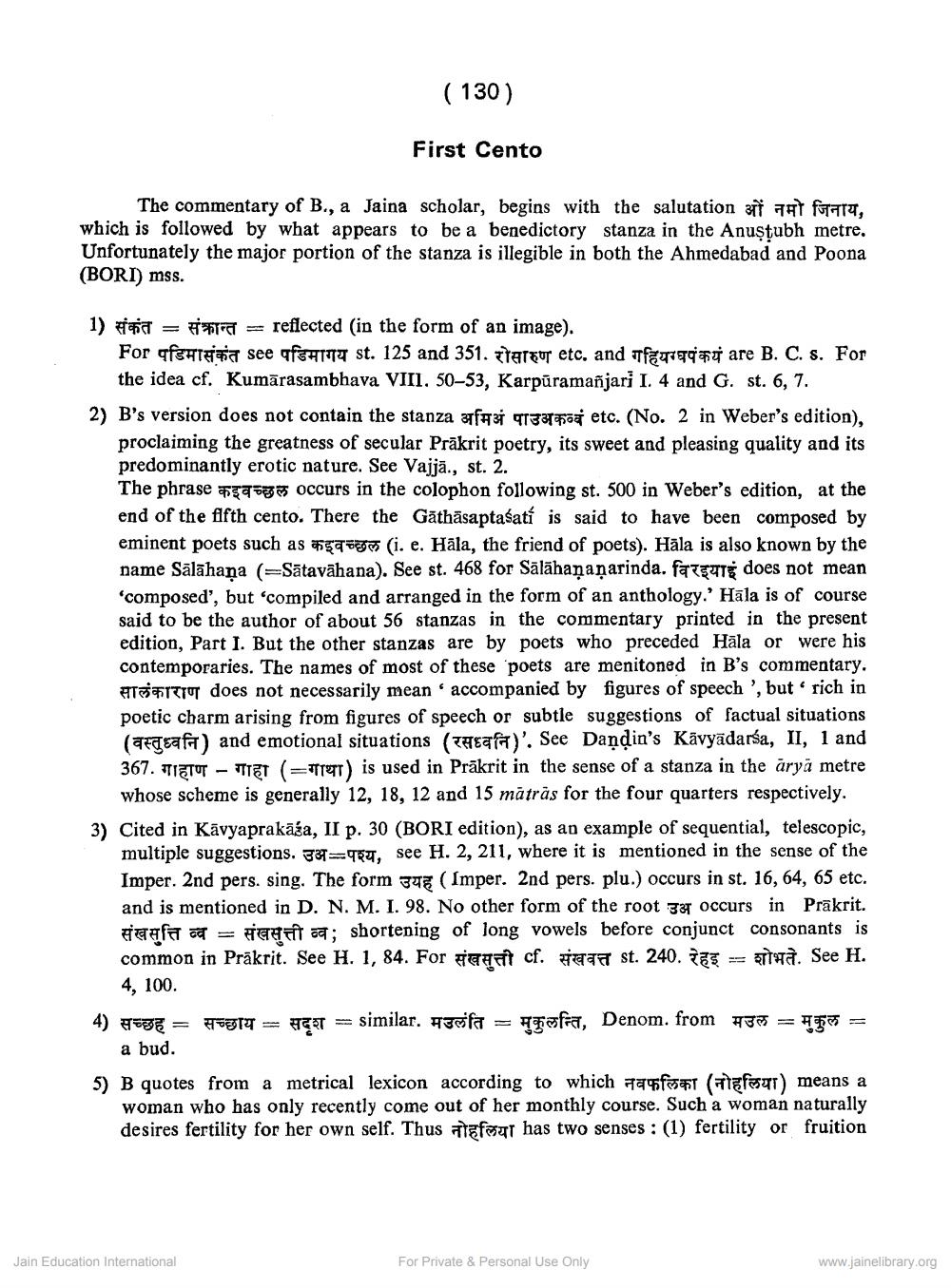________________
( 130 )
First Cento
The commentary of B., a Jaina scholar, begins with the salutation af at fata, which is followed by what appears to be a benedictory stanza in the Anuştubh metre. Unfortunately the major portion of the stanza is illegible in both the Ahmedabad and Poona (BORI) mss.
1) = # = reflected in the form of an image).
For पडिमासंकेत see पडिमागय st. 125 and 351. रोसारुण etc. and गहियग्घकयं are B.C. s. For
the idea cf. Kumārasambhava VIII, 50–53, Karpūramañjarj I. 4 and G. st. 6, 7. 2) B's version does not contain the stanza afazi 91330d etc. (No. 2 in Weber's edition),
proclaiming the greatness of secular Prākrit poetry, its sweet and pleasing quality and its predominantly erotic nature. See Vajjā., st. 2. The phrase #8753occurs in the colophon following st. 500 in Weber's edition, at the end of the fifth cento. There the Gāthāsaptaśatí is said to have been composed by eminent poets such as **T*** (i. e. Hāla, the friend of poets). Hāla is also known by the name Sālāhaņa (Sātavāhana). See st. 468 for Sālāhaņaņarinda. fargeg does not mean 'composed', but compiled and arranged in the form of an anthology.' Hāla is of course said to be the author of about 56 stanzas in the commentary printed in the present edition, Part I. But the other stanzas are by poets who preceded Hāla or were his contemporaries. The names of most of these poets are menitoned in B's commentary. ATTFITIUT does not necessarily mean accompanied by figures of speech', but rich in poetic charm arising from figures of speech or subtle suggestions of factual situations (arceaft) and emotional situations (ETF)'. See Dandin's Kävyädarśa, II, 1 and 367. TIETOT – TIET ( TIT) is used in Prākrit in the sense of a stanza in the aryä metre
whose scheme is generally 12, 18, 12 and 15 mātrās for the four quarters respectively. 3) Cited in Kavyaprakāža, II p. 30 (BORI edition), as an example of sequential, telescopic,
multiple suggestions. 339=964, see H. 2, 211, where it is mentioned in the sense of the Imper. 2nd pers. sing. The form zuk (Imper. 2nd pers. plu.) occurs in st. 16, 64, 65 etc. and is mentioned in D. N. M. I. 98. No other form of the root 32 occurs in Prakrit. संखसुत्ति व्व = संखसत्ती व्व; shortening of long vowels before conjunct consonants is common in Prākrit. See H. 1, 84. For gent cf. af st. 240. ET = Ha. See H.
4, 100 4) 737 = 779TT = AT = similar. Fefa = poffa, Denom. from 3* = 55 =
a bud. 5) Bquotes from a metrical lexicon according to which नवफलिका (नोहलिया) means a
woman who has only recently come out of her monthly course. Such a woman naturally desires fertility for her own self. Thus tafaur has two senses : (1) fertility or fruition
Jain Education International
For Private & Personal Use Only
www.jainelibrary.org




